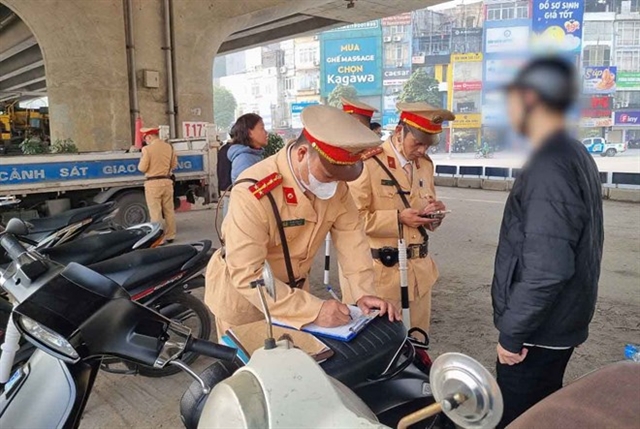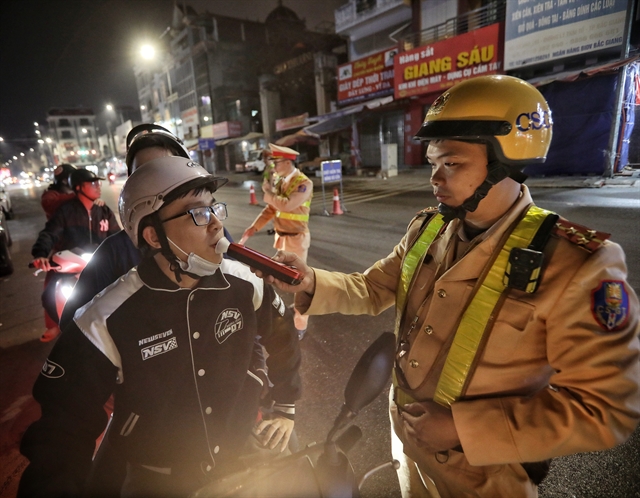 Politics & Law
Politics & Law

 |
| Traffic police check alcohol levels for drivers in the northern province of Bắc Giang. — VNA/VNS Photo Danh Lam |
HÀ NỘI — Experts on Wednesday discussed measures to improve traffic safety for motorbike drivers in Việt Nam, sharing many challenges and lessons learned on ways to make improvements.
At the conference, held by the National Traffic Safety Committee (NTSC), Lê Kim Thành, Deputy Chairman of the NTSC, said that motorbikes were still the main means of transport for Vietnamese people, with about 77 million vehicles registered by the end of last year.
"Until 2030 and beyond, when incomes continue to increase, it is likely that motorbikes will still be owned and used," said Thành.
Analysing the causes of accidents, he said the main ones were inadequate road infrastructure and how low personal income and transportation services in provinces and cities have not met travel needs, so motorbikes are the priority choice, playing an important role in people's lives and livelihoods.
For example, Hà Nội and HCM City are the two largest cities with the most developed transport infrastructure in the country, but the public transport system only meets about 10-15 per cent of travel demands.
The number of buses per million people is much lower than in other Asian cities.
"If the construction and expansion of road networks and public transport continues at the current pace, within the next ten years, public transport will still not be able to meet demand and motorbikes will continue to be the preferred means of transport for many people," he added.
However, the NTSC’s statistics showed that motorbikes are involved in about 65-70 per cent of traffic accidents and in many of them, the motorbike rider is the victim.
Thành acknowledged that due to the popularity of motorbikes, along with transportation characteristics in Việt Nam, implementing solutions to improve traffic safety for motorbikes was an important issue for millions of people using mopeds and motorbikes every day and would certainly contribute to improving traffic safety in the country.
Challenges
Chief of Office of the NTSC, Trần Hữu Minh, added that in Việt Nam, over many years, with the combined efforts of the entire political system, ensuring traffic safety and order has achieved very positive results.
In particular, in Việt Nam, the use of helmets is to be applauded compared to levels in the international community. Today more than 90 per cent of riders wear a helmet, rising to 95 per cent in some places.
Việt Nam is also doing very well in controlling motorbike riders' alcohol concentration and speed control.
However, many challenges remain, such as the 16-18 age group driving motorbikes under 50cc but lacking knowledge and skills to control the vehicle. The number of traffic accidents involving children under 16 years old driving two-wheeled vehicles is complicated. Many traffic accidents are due to violations of traffic rules, such as turning without looking at oncoming traffic.
On the other hand, motorcycle lane standards and design guidelines for dedicated motorcycle lanes have not been widely applied.
Notably, there are no regulations on penalties for children under six years old sitting on motorbikes without helmets, no standards for motorbike helmets for children under six years old, and no regulations on safety equipment for children on motorbikes, so the rate of children wearing helmets on motorbikes is still low.
Measures
Minh suggested changing the training programme and driving licence testing for motorcyclists to be more rigorous and raising awareness of risks related to speed, alcohol, helmets and phone use while driving.
Training should focus on practicing skills, rules when changing directions, blind spots, using mirrors, and driving at night.
At the same time, it supplements the knowledge and skills for car drivers when participating in mixed traffic with motorbikes.
Next, it is necessary to have legal regulations on the design of motorbike traffic infrastructure, such as separate lane standards for motorbikes and more training and testing for students driving vehicles under 50cc.
Minh also proposed enhancing motorbike safety by introducing additional equipment and leveraging technology for more effective enforcement of traffic regulations.
Dương Khánh Vân, from the WHO Việt Nam, believes that Việt Nam should continue to encourage the increase in the numbers of those using helmets, focus on post-accident response and activate the emergency care system for people injured after traffic collisions. — VNS